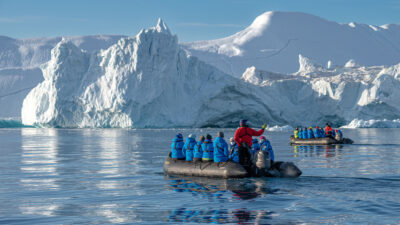Video | Canadian High Arctic and Greenland
Top of the World: Ilulissat, Iceberg Capital of the World
By Adventure Canada | January 28, 2022
Related expedition: Greenland and Arctic Canada: High Arctic Explorer and The Northwest Passage
Video | Canadian High Arctic and Greenland
By Adventure Canada | January 28, 2022
Related expedition: Greenland and Arctic Canada: High Arctic Explorer and The Northwest Passage
On the west coast of Greenland, on the shores of Disko Bay, lies a small town with a population of just 4,500 people. The town was established as a trading post in 1741, and called Jakobshavn in honor of Jakob Severin, a Danish merchant.
Today it's known as Ilulissat, a Greenlandic name, meaning "iceberg". And that's fitting, because Ilulissat is the iceberg capital the world.
Ilulissat lies alongside the Ilulissat Icefjord, a UNESCO World Heritage Site. The icefjord is an arm of Baffin Bay, choked with chunks of ice broken off the Sermeq Kujalleq glacier, an arm of Greenland's vast ice cap.
Over thirty-five cubic kilometers of icebergs calve off the face of Sermeq Kujalleq each year, amounting to 10% of Greenland's total and more than any other glacier outside Antarctica.
The warm West Greenland current carries those mighty bergs northward toward the top of Baffin Bay. There, southbound cold currents take them south along the east coast of Baffin Island.
Shrinking and breaking as they go, some of those icebergs survive the journey all the way to the coast of Newfoundland. That's where one particular iceberg entered the history books: the one that Titanic struck in April of 1912.
Very probably, this deadly berg had its origins at the Ilulissat Icefjord. Just like the ones people flock to Newfoundland to view each year, the Ilulissat Icefjord has been studied extensively for 250 years, leading to a far better understanding of glaciers and iceberg formation.
Today's warming temperatures mean the icebergs are melting at a faster rate than ever, and constant retreat of the Sermeq Kujalleq glacial face will eventually leave it grounded.
Once that happens, the iconic icebergs of Ilulissat will effectively become extinct, and the era of the big ice will be at its end.
For now, Ilulissat continues to fascinate scientists looking to unlock its secrets and visitors from around the world seeking the awe-inspiring wonder of mighty ice.

©Steven Rose
August 15 to August 27, 2024
From $9,995 to $18,295 USD
per person based on double occupancy
Save 25%
Terms and conditions apply

©Jen Derbach
August 3 to August 15, 2024
From $9,995 to $18,295 USD
per person based on double occupancy
Save 25%
Applies to berth cost only

©Dennis Minty
August 27 to September 12, 2024
From $13,995 to $28,495 USD
per person based on double occupancy
Save 25%
Applies to berth cost only

©Dennis Minty
September 12 to September 28, 2024
From $13,995 to $28,495 USD
per person based on double occupancy
Save 25%
Applies to berth cost only.

©Dennis Minty
August 16 to September 1, 2025
From $14,495 to $28,995 USD
per person based on double occupancy
Save 25% for a limited time!
Applies to berth cost only

©Scott Forsyth
September 1 to September 17, 2025
From $14,495 to $28,995 USD
per person based on double occupancy
Save 25% for a limited time!
Applies to berth cost only